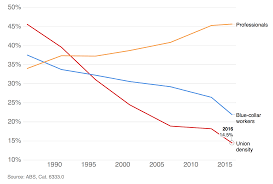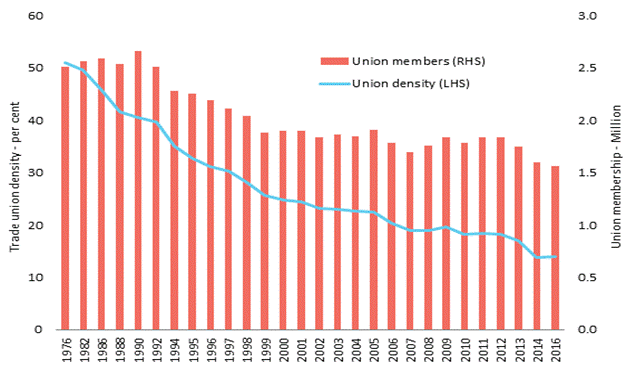-
Best Australian Pokies Best Payout
Play Free 777 Pokies Online
What Are the Best Australian Pokies to Win Big On
What Are the Best Online Pokies with Low Minimum Deposits for Real Money in Australia
New Australian Pokies Accepting PayID
What Are the Best Strategies to Win in Online Pokies with Bonus Rounds in Australia
Tips for Winning Top Australian Pokies
What Online Casinos Offer Free Play Pokies with Welcome Bonuses in Australia
Australian Slot Games
Payout Ratio Pokies with Welcome Bonus

Trends in union membership in Australia. An analysis of decline in union membership in Australia
Trends in union membership in Australia
Executive summary
- The number of union members in Australia has declined from around 2.5 million in 1976 to 1.5 million in 2016. During the same period the union member share of all employees (or union density) has fallen from 51 per cent to 14 per cent.
- Young workers are much less likely to be union members than older workers and casual and/or part-time employees are less likely to be union members than full-time workers and permanent employees.
- Industry union density is strongest in Education and training and Public administration and safety.
- The biggest increases in union membership over the last decade and a half were recorded by the Police Federation of Australia (PFA) (up 92 per cent), Australian Nursing and Midwifery Federation (ANMF) (up 84 per cent), and Independent Education Union of Australia (IEUA) (up 35 per cent).
Contents
Introduction
Figure 1—trends in level of union membership and union density—1976 to 2016
Reasons for decline in union membership
Hours worked and access to leave entitlements
Table 1—union density by employee type—August 2016
Age and sex
Industry
Table 2—union density (%) by industry —various years from 1994 to 2016
Specific union membership
Table 3—change in union membership levels for specific unions—2003 and 2017
International trends
Table 4—union density in selected OECD countries—1980 to 2016 (per cent of employees)
Introduction
This statistical snapshot outlines the decline in union membership in Australia over the past forty years using the latest data available and considers possible reasons for the decline.
Union membership in Australia has been falling steadily over the past four decades. There were just over 1.5 million union members in 2016, compared with just over 2.5 million in 1976. This represents a decline of around 1 million union members or 38 per cent. During the same period union density (the union member share of total employment) has fallen from 51 per cent to 14 per cent.
Figure 1—trends in level of union membership and union density—1976 to 2016

Sources: 1976–1993: ABS, Trade Union Members, cat. no. 6325.0; 1994–2013: ABS, Employee Earnings Benefits and Trade Union Membership, cat. no. 6310.0; 2014–2016: ABS, Characteristics of Employment, cat. no. 6333.0[1]
Reasons for decline in union membership
Union membership has been declining in Australia for a number of reasons including:
- steady decline in employment in industries that traditionally had high concentrations of union membership—such as large scale car manufacturing; printing; and textile, clothing and footwear—due to economic re‑structuring[2] and the transition to new forms of media
- the collapse of compulsory unionism (or closed shops) in Australia during the 1980s and 1990s. Under the federal Workplace Relations Act 1996, union preference and compulsory unionism was made illegal both for employees covered by the federal system and for those outside but within reach of other Commonwealth powers[3]. Similar legislative changes prohibiting compulsory unionisation were enacted by state governments[4].
- decreasing prevalence of union members in industries that previously had a much stronger union member presence (including in Manufacturing and Transport, postal and warehousing)[5].
- strong growth in employment in service industries that have traditionally had relatively low union presence such as Retail trade and Accommodation and food services[6]
- growth in part-time and/or casual employment across most industries and occupations and relative decline in the permanent and full-time employment share of total employment. The following section of this report shows part-time and/or casual employees are less likely to be union members.
Hours worked and access to leave entitlements
Table 1 shows part–time and/or casual employees (or employees without access to leave entitlements) are less likely to become union members and increasing use of this employee type by employers across a range of industries has contributed to the lowering of overall union density.
Attachments
